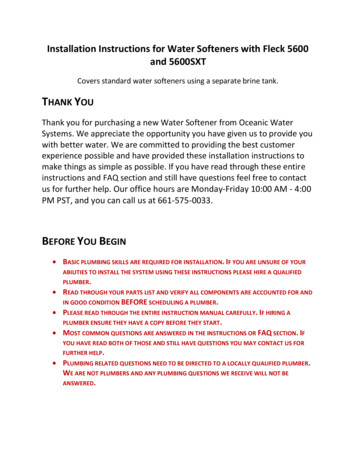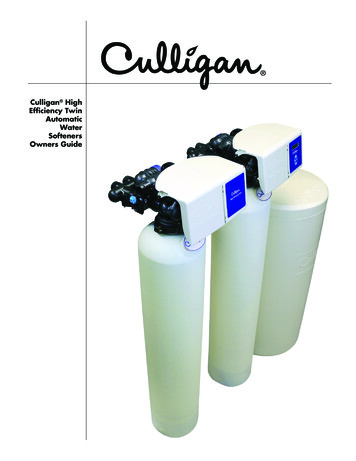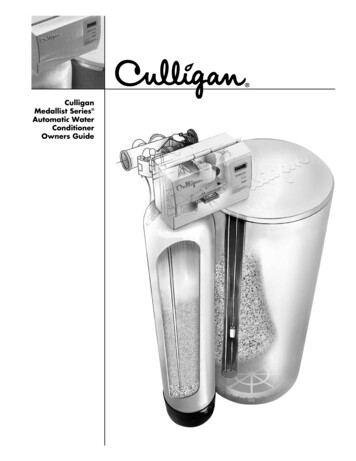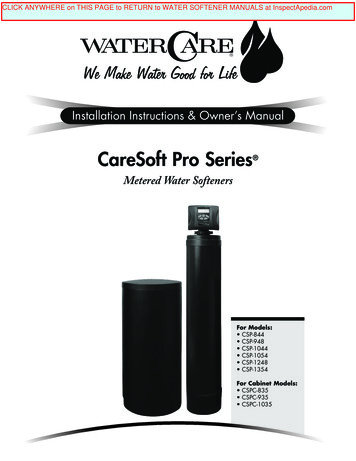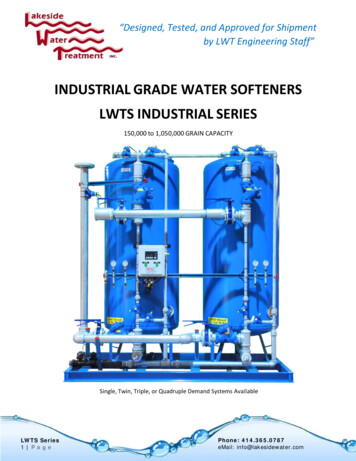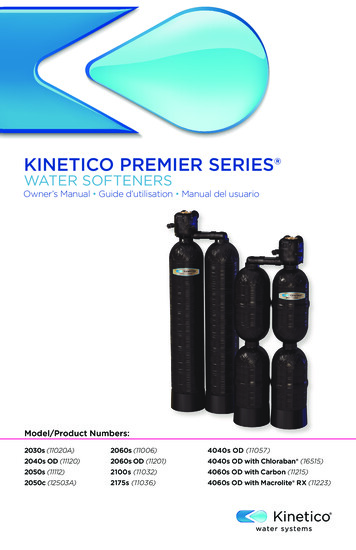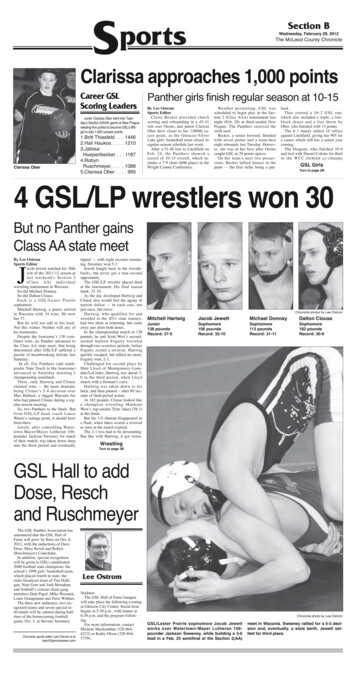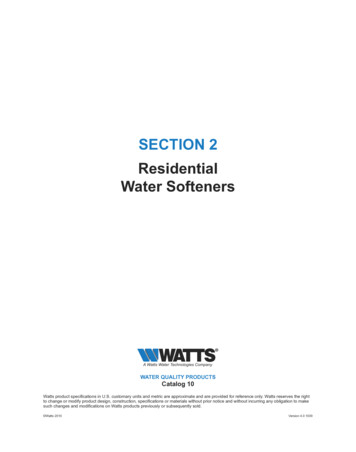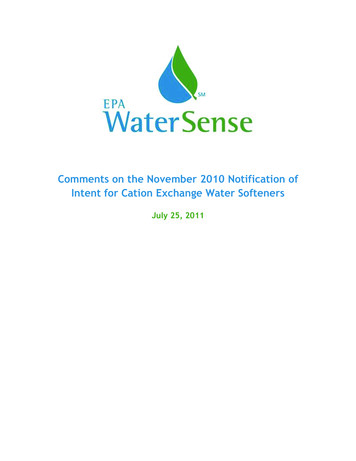
Transcription
Comments on the November 2010 Notification ofIntent for Cation Exchange Water SoftenersJuly 25, 2011
Comments on the Cation ExchangeWater Softener Notification of IntentCommenterBarry Schultz . 3Steven Richards . 4Ken Hoffman . 5Thomas Griesbach . 6Ken Hoffman . 7Todd Fessenden . 8Kevin Wong . 9Multiple Authors . 10Jeff Hellenbrand . 11Mike Mormino. 13John Beaver . 14Steve Via . 15Gary Thundercliffe . 16Sharon Green. 17Larry Zinser . 18Nancy Stoner . 19Thomas Armon. 20Multiple Authors . 212July 25, 2011
Comments on the Cation ExchangeWater Softener Notification of IntentCommenter: Barry SchultzAffiliation: EarthSaversO2Comment Date: November 22, 2010As a plumbing contractor for the last 30 years, and cross training in 2007 to be a energy starHPS/BPS with my son Brook. I want to say. Yes It would be nice to look into getting watersofteners get watersence labeling. It would also be good to have them energy star labeled.I haveseen some nice softeners out there. And I don't think there will be anyproblem.Except. The in-expensive ones.WaterSence is a great program toadd to the energy star program! Its a privileged to be a part of the programs that work, Its good toour earth and mankind.Keep up all the GOOD work! Barry Schultz Sr Earthsaverso23July 25, 2011
Comments on the Cation ExchangeWater Softener Notification of IntentCommenter: Steven RichardsAffiliation: The Aquasource Group, Inc.Comment Date: November 24, 2010Hello.Please accept my comments regarding Ion Exchange water softener efficiencies.1. Great Idea ! Not only will this reduce water useage, this action will also help the environment byreducing waste water for sewer plants as well as individual septic systems.2. The water softener industry is made up of both manufacturers and assemblers. Assemblersshould be able to leverage the certification of the manufactured components hat they use forcertification of thier completed product. This will lower the cost of compliance and event he playingfield.Best Regards,Steven L. Richards CWS VIPresidentThe Aquasource Group Inc.The Water PeopleMain Office8960 Main StreetHoneoye, NY 14471Phone: 585.229.2500Fax: July 25, 2011
Comments on the Cation ExchangeWater Softener Notification of IntentCommenter: Ken HoffmanAffiliation: LifeSource Water SystemsComment Date: November 29, 2010Gentlemen,With respect to the WaterSense NOI for cation exchange systems, I respectfully submit that:1. The NOI category to broadened to include all “point-of-entry” (whole house) water systemsas both types of systems are installed on the main water line in a similar manner.2. Consideration should be given to non-salt based, whole house water systems which canachieve zero water waste, thereby achieving the primary goal of the WaterSense program.In comparison, regenerative water softeners, for residential and commercial use, havebeen banned in many communities due to the chloride effluent’s effect on reclaimed waterusage and the environment.Here are a few unintended consequences or negative results directly related to water softeners:1. Usage of plastic bottled water to provide potable drinking water in homes using watersofteners, specifically the negative effect that plastic bottles have in land fills.2. Usage of high water wasting reverse osmosis systems to provide potable drinking water inhomes using water softeners.3. The negative health effects of “softened” water on several segments of the population.4. The negative health effects of reverse osmosis water on several segments of thepopulation.At your request, I’d be happy to provide more information and direct you to various governmental,environmental, medical and private sources to support the above.Cordially,Ken HoffmannLifeSource Water SystemsCell: 818-633-51625July 25, 2011
Comments on the Cation ExchangeWater Softener Notification of IntentCommenter: Thomas GriesbachAffiliation: Diamond H2OComment Date: December 7, 2010To whom it may concernMy company is an OEM located in Wisconsin and would like to better understand all the long termintentions with this project.Also, I understand the watersense program is already being used for other products.Do you have any testimonials or written comments from those manufacturers?My concern: Are we writing the standards so that the EPA can enforce them upon us in the future?If so, we need to SHRINK regulations/government not look for things to grow it and make it moredifficult and expensive to conduct business.Your prompt response would be greatly appreciated.Regards,Thomas G. GriesbachPresidentDiamond H2O6July 25, 2011
Comments on the Cation ExchangeWater Softener Notification of IntentCommenter: Ken HoffmanAffiliation: LifeSource Water SystemsComment Date: December 20, 2010You may find the attached report to be of value as you consider the proposed Water SoftenerprogramCordially,Ken HoffmannLifeSource Water SystemsCell: 818-633-5162(Attachment: Southern California Salinity Coalition Final Project Report: Automatic Water SoftenerRebate Program – Phase II: Public Outreach Program). Electronic copy available ftenerOutreach12.20.10.pdf)7July 25, 2011
Comments on the Cation ExchangeWater Softener Notification of IntentCommenter: Todd FessendenAffiliation: Eagle River Water and Sanitation DistrictComment Date: December 29, 2010For us in the Vail Valley, softeners are more than just a wastewater issue. A large part of ourservice area comprises of second homes and resorts. Almost all of these locations are fitted withsofteners for both aesthetic and perceived quality improvements. We have found that a largeportion of our customer complaints derive from softener generated plumbing issues. Large homeswith copper piping that has not had the opportunity to scale naturally sit for long periods withoutuse. When the residents or visitors finally arrive and these systems fire up for the first time we seeincreases of copper loading to our wastewater plants. A the same time we get regular calls fromcustomers with internal plumbing problems related to corrosion. Completely soft water isaggressive due to its lack of alkalinity and general chemical imbalance and does strange things tointernal plumbing components. That problem is exacerbated by long periods of dormancy in homesand hotels. We add corrosion inhibitor, but that only goes so far when the systems are not beingrun regularly. This situation can also create higher copper levels in drinking water as well. I’d loveto see the softener industry go away, or develop a system that leaves about 3 grains per gallon inthe water to protect the piping, the customers and the watersheds.Thank you,Todd FessendenWater Division ManagerEagle River Water and Sanitation District970-477-54718July 25, 2011
Comments on the Cation ExchangeWater Softener Notification of IntentCommenter: Kevin WongAffiliation: Canadian Water Quality AssociationComment Date: January 19, 2011Here you goKevin Wong, BSc, MBA, CAEExecutive DirectorCanadian Water Quality Association295 The West Mall, Suite 330Toronto, ON M9C 4Z4T: (416) 695-3068 ext 312 Toll Free: 1-866-383-7617F: (416) 695-2945E: k.wong@cwqa.comWebsite: www.cwqa.com Please consider the environment before printing this e-mail(Attachments: Region of Waterloo Water Softener Study presentation for Canadian Water QualityAssociation July 28th, 2010; Guidance for the Use of Water Softening and Onsite WastewaterTreatment Equipment at the Same Site by WQA and NOWRA; Ontario Residential Fire Sprinklers& On-site Sewage Systems: A Consultation on Proposed Changes to Ontario’s Building Code.Electronic copy available at www.ontario.ca/buildingcode)9July 25, 2011
7/25/2011Region of WaterlooWater Softener StudyJuly 28th 2010Soft Water Benefits– Descaling Effects - saves energy & longevity ofappliances– Soft water better for skin (UK Study- ongoing) Aesthetic and health based effects– Costs and benefits in very hard waterenvironments1
7/25/2011Soft Water Challenges– Chlorides– Efficiency– Wastewater discharges– TDS difficult to remove from the waste water stream & mayend up discharging to the natural environment (guidelinescoming).– Implications to MOE objectives, Great Lakes and surface wateragendas– Reg 903 and the Region’s wells.Background 2008– MOE alerts Region of increasing trends ofchlorides at their surface water monitoring sites(MOE surface water Monitoring data 2003-2008)– Potential sources Road and winter de-icing salt Potash fertilizers SoftenersHow do you manage all these sources?2
7/25/2011Background Region Survey– 72% of residences have a water softener– Probably 100% of local businesses have one ontheir boilers for the hot water to protect thesystems. Industry– 100 Water treatment companies serving theregion (50% are members)– 1000 people employed in the industryEmerging Challenges for a LeadingMunicipality in Canada Water Conservation (softeners dischargeregeneration waters) Energy Efficiency Challenges Wastewater Challenges– At the plant– Greywater policies forming3
7/25/2011Softeners Theoretical limit» 4400 grains of hardness per pound of salt used forregeneration.» This works out to about 75,000ppm of hardness removed.» At 600 ppm total hardness, this works out to about125L/lb Salt.Softeners Historical (old) performance» 3000 grains of hardness per pound of salt used inregeneration Today’s (average) performance» 4000 grains of hardness per pound of salt used inregeneration» This is at standard settings not a water conservative orsalt saving settings» This brings the water to 0-1 gr hardness» People don’t see/fell hard water till it’s over 3 gr hard 4
7/25/2011The Water TrialsObjectives1. To measure the efficiency of water softeners.2. To verify the size of softener local homeowners need,based on usage and the relative performance of therecommended softeners.3. To publish results that educate consumers, plumbersand retailers about water softeners.4. To more accurately measure the impacts of residentialwater softening on drinking water demand andwastewater treatment.5. To gather information for future Region of Waterloopolicies and programs.Results This is an independent study and some good data was developed in the April 2010 Trial #1 report. Three watersofteners were tested on 39 gpg hard water and all performed very well - - all consistently providing softenedwater below 1 grain per gallon. The three residential softeners were 1) Culligan Medalist Plus 30 Model (labeledXXX), 2) EcoWater Automatic Model GS6225D (labeled XX), and 3) Novatek Model NT32SE with a WaterGroup Inc.control valve (labeled X). Important characteristics that they found are: For Brand XXX: 62 gallons per regeneration; regeneration discharges to wastewater 2.7 gallons per each 1,000grains of hardness exchange; salt used 0.21 pounds of NaCl per each 1,000 grains of hardness exchanged.1.08lb For Brand XX: 23 gallons per regeneration; regeneration discharges to wastewater 2.5 gallons per each 1,000grains of hardness exchange; salt used 0.26 pounds of NaCl per each 1,000 grains of hardness exchange.1.144lbs For Brand X: 54 gallons per regeneration; regeneration discharges to wastewater 2.0 gallons per each 1,000grains of hardness exchange; salt used 0.25 pounds of NaCl per each 1,000 grains of hardness exchange.1.1lbs These kinds of numbers, for example, may all be satisfactory for meeting USEPA WaterSense criteria andexpectations. They all are about 50% lower (better) than the NSF/ANSI Standard 44 requirements for waterefficiency ratings and they are all at or very near 4,000 grains of hardness exchange per pound of salt used.5
7/25/2011The results look great 3.06 people per average household61.8 gallons of water used per person per day193 gallons of water used per household per dayPeak water flow rate 8.7 gallons per minuteAverage water flow rate 4.5 gallons per minuteMinimum water flow rate (assumed leaks) 0.26gallons per minute.Next Steps Recommendations Continue with the softener trials- CWQA’s members areready to assist and donate units for testing. In future trials- move to a high efficiency settings tomaximize the efficiency of the softeners Future strategies– Promote softener servicing – get homeowners and businessesto service their softeners and have the service person checkfor the settings6
7/25/2011Questions?We are here to help7
Comments on the Cation ExchangeWater Softener Notification of IntentCommenter: Multiple AuthorsAffiliation: Undersigned AgenciesComment Date: January 25, 201110July 25, 2011
Association of California Water Agencies (ACWA)Association of Metropolitan Water Agencies (AMWA)California Association of Sanitation Agencies (CASA)California Municipal Utilities Association (CMUA)City of Phoenix, Water Services DepartmentCity of Scottsdale, Water ResourcesClean Water ActionInland Empire Utilities AgencyLas Cruces UtilitiesMetro Wastewater Reclamation DistrictMulti-State Salinity CoalitionNational Association of Clean Water Agencies (NACWA)National Water Research InstituteNational Resources Defense CouncilPlanning and Conservation LeagueSanitation Districts of Los Angeles CountySouthern California Alliance of Publicly Owned Treatment Works (SCAP)Southern California Salinity CoalitionSouthern California Water CommitteeTri-TACWateReuse AssociationWateReuse CaliforniaWestern Coalition of Arid States (WESTCAS)January 25, 2011Peter S. Silva, Assistant AdministratorOffice of WaterEnvironmental Protection AgencyAriel Rios Building1200 Pennsylvania Avenue, N.W.Mailcode 4101MWashington, DC 20460Subject:WaterSense Notification of Intent to Develop Efficiency and PerformanceSpecifications for Residential Cation Exchange Water SoftenersDear Mr. Silva:The undersigned organizations are writing to call to your attention our concerns regarding theNotification of Intent (NOI) to Develop Efficiency and Performance Specifications forResidential Cation Exchange Water Softeners by the U.S. Environmental Protection Agency’s(EPA’s) WaterSense Program. For the reasons indicated below, we urge that the NOI be
Peter S. SilvaPage Twoexpanded to include non-salt discharging appliances. We request the opportunity to meet withyou, at your earliest convenience, to discuss potential solutions to these concerns. We believethat we can work with you to develop a fully integrated approach that will work for WaterSensePartners throughout the nation.The undersigned organizations are all strong supporters of the Environmental ProtectionAgency’s WaterSense program. We firmly believe in the importance of improving the waterefficiency of appliances, buildings, and landscapes, and in the significance of creating an easilyrecognizable “brand” for products with the highest water efficiency ratings. Indeed, many of theundersigned organizations are WaterSense Partners. We actively promote the water efficientproducts endorsed by the EPA through this program.We understand that typical Cation Exchange Water Softeners (also known as Self-RegeneratingWater Softeners (SRWS)) used in homes are water intensive. These devices are also veryeffective at removing hardness from water, which means they are useful for protecting otherwater and energy efficient appliances from the impacts of calcium and magnesium that are foundin local water supplies. For WaterSense to identify self regenerating water softeners ascandidates for evaluation is understandable.The problem is the amount of salt that this type of water softener discharges to the sewer systemon average 1 pound or more of salt per day. From a national perspective, this is a significantwater quality concern, potentially contributing to impairments in surface and groundwatersupplies. The EPA’s 303 (d) impaired waters list shows almost 1,800 listings across the countrydue to salinity or related compounds (including total dissolved solids, chloride, sulfates,conductivity and/or combinations of these compounds). High levels of salt entering sewersystems also compromise the ability of communities to use recycled water when salinity in thesesupplies rises to unacceptable levels.Salt management is a major water challenge facing our nation, especially, though notexclusively, in the arid West. The EPA, along with the Department of Agriculture and theDepartment of Interior, have congressional mandates for implementing programs to reduce saltimpacts, including the Colorado River Salinity Control Act and the joint federal/Californiainitiative to protect the San Francisco Bay Delta. In addition, these agencies, along with the U.S.Council on Environmental Quality, are promoting the use of recycled water as a water efficiencymeasure.Many communities throughout the nation have found self-regenerating water softeners to be asignificant contributor to pollutant loadings. Local and state agencies in California, Texas,Arizona, Montana, Kentucky, Michigan, Massachusetts, Connecticut, and New Jersey andelsewhere have at one time enacted or are now contemplating laws, regulations, and ordinancesto limit or ban the use of self-regenerating water softeners.
Peter S. SilvaPage ThreeUnderstandably, for those of us who have been working for decades and spending ratepayerdollars to reduce salt loadings into our systems, the possibility of an EPA WaterSense labellimited to devices that discharge significant quantities of salt (even if the amount could be lessthan comparable softeners) is of profound concern. If approved as proposed by the NOI, such aWaterSense specification would preclude many WaterSense partners from promoting the watersoftener specification.We have spoken with the WaterSense staff about this problem, and understand that the existingprogram guidelines currently preclude a better approach to identifying the appropriate waterefficient product for the control of hardness or scale. Staff indicates that the WaterSense processis limited to a consideration of older technology that may be able to achieve a 20% or moreimprovement in water efficiency. This means that the available alternative technologies (used inEurope and now starting to be introduced into the American market) that use neither water norsalt cannot be evaluated in the WaterSense Program – even though these appliances mayachieve 100% water efficiency while protecting the nation’s water quality.Our recommendation is that the WaterSense program guidelines be modified to permitevaluation of non-water using technologies and that the NOI be revised so that the EPA canevaluate and compare salt and non-salt discharging appliances.Admittedly, this will be a somewhat more extensive and challenging task than the evaluationcontemplated under the NOI, but the benefits to the public and to the implementation of theClean Water Act will be substantial.In summary, we strongly believe that there is a better way to integrate EPA’s water resource andwater quality goals through the WaterSense Program. We are committed to working with youand the WaterSense program to develop a broader water softener evaluation initiative.Thank you for your consideration of our request to meet with you at your earliest convenience todiscuss our concerns and a possible new joint initiative.Sincerely,Tim QuinnExecutive DirectorAssociation of California Water AgenciesCatherine SmithExecutive DirectorCalifornia Association of Sanitation Agencies
Peter S. SilvaPage FourDavid ModisetteExecutive DirectorCalifornia Municipal Utilities AssociationMarshal BrownWater Resources Executive DirectorCity of ScottsdaleJennifer ClaryPolicy AnalystClean WaterEdmund G. ArchuletaMSSC ChairmanPresident and CEOEl Paso Water UtilitiesThomas A. LoveGeneral ManagerInland Empire Utilities AgencyJoshua RosenblattRegulatory & Environmental AnalystLas Cruces UtilitiesBarbara BiggsGovernmental Affairs OfficerMetro Wastewater Reclamation DistrictKen KirkExecutive DirectorNational Association of Clean Water AgenciesOwned Treatment WorksEd OsannSenior Policy AnalystNational Resources Defense CouncilJeff MosherExecutive DirectorNational Water Research InstituteJonas MintonSenior Water Policy AdvisorPlanning and Conservation League
Peter S. SilvaPage FiveJohn PastoreExecutive DirectorSouthern California Alliance of PubliclyOwned Treatment WorksRichard W. AtwaterExecutive DirectorSouthern California Water CommitteeMark R. NortonChairSouthern California Salinity CoalitionBen HorensteinChairTri-TACRobert HollanderPresidentWestern Coalition of Arid StatesDave SmithManaging DirectorWateReuse CaliforniaWade MillerExecutive DirectorWateReuse AssociationDiane Van De HeinExecutive DirectorAssociation of Metropolitan Water Agenciescc:Philip L. FriessDepartment Head, Technical ServicesSanitation Districts of Los Angeles CountyNancy Stoner, Deputy AdministratorBob Perciasepe, EPA Assistant Administrator for WaterJim Hanlon, Director, EPA Office of Wastewater ManagementVeronica Blette, WaterSense Program, EPA Office of Wastewater ManagementAlexis Strauss, Director, EPA Region IX Water DivisionTom Howard, Executive Director, California Water Resources Control Board
Comments on the Cation ExchangeWater Softener Notification of IntentCommenter: Jeff HellenbrandAffiliation: Hellenbrand, Inc.Comment Date: January 31, 2011Dear WaterSense,First off thank you for the invitation to participate in the webinar/conference call on Wednesday1/19. My understanding is that the two main goals of this possible program is to reduce waterusage for regeneration purposes and to reduce the amount of chlorides. Several other items werebrought up, including but not limited to the sodium and chloride impacts on septic tanks andchloride and tds impacts on wastewater treatment plants.In general to accomplish these goals WaterSense wishes to expand on the existing NSF/ANSI 44standard and is considering adopting a salt-efficiency requirement of at least 4,000 grains per lb. ofsalt, looking at a regeneration efficiency by not regenerating with "x" amount or less ofcapacity remaining, along with reducing the amount of water used during a regeneration process.Based on testing we are presently doing, achieving both the salt efficiency and water usage aredoable. Maintaining that salt efficiency over extended repeated regenerations without anoccasional "boost" of salt is a concern to both us a manufacturer and our dealers, as it is wellknown that over period of time with low salt dosages these efficiencies cannot be maintained.This results in hardwater leakage before the next regeneration and unhappy customers,a "lose lose" for everyone in the chain, customer, dealer and manufacturer. Perhaps however thatcan be addressed in the standard.Regarding the regeneration efficiency or not regenerating too soon based on the variousmathematical formula's used by the control valve manufacturers, that one is really a tough one witha single tank system. Simply looking at a home application as the family size increases theaccuracy of the various mathematical formula's used to determine the reserve required has alarger chance of having more wasted capacity. As does the type of family, age of the familymembers .etc. Twin alternating systems are by far the most efficient as you are able to basciallyexhaust the system to nearly zero, switch tanks and then regenerate the exhausted tank. Yearsago I did a study of my single tank, electronic DIR with "variable reserve" and found my wife and Icould save 15% on salt and water usage with a twin tank based on our erractic water usagepatterns with frequent out of town travel.One thing that I have not seen mentioned that I believe would have a positive impact on watersavings, is how the various plumbing codes impact water higher water usage, larger footprints.etc. which requires larger water softeners to be sized. I have attached a copy of a sizing chartthat the State of WI uses to further assist you in understanding this, along with a spreadsheetshowing how the gallon per minute or "gpm" requirement is calculated, for a 3.5 bath house, with adishwasher, kitchen sink, ice-maker, clothes washer, with laundry tray and whirlpool bath. This"overkill" requires larger units to be installed to meet the service flow rate requirements, which inturn require more water to be used to regenerate the water softener. It also is less green because itrequires a larger footprint, larger pipe size .etc. Ironically WI adopted an "alternative sizing" forresidential homes that has been in place for approximately ten-years that has worked very well.Basically it allows you to take a home that would normally require upto 24 gpm to be sized at an8.5 gpm demand. Loretta Trapp and I were very involved in this process on behalf of the WQAseveral years ago. The entire plumbing code needs to be reviewed in this area, for both residential11July 25, 2011
Comments on the Cation ExchangeWater Softener Notification of Intentapplications, commercial and industrial jobs across the U.S. as it would more than likely result inless water usage, smaller pipe sizes which in turn would reduce the energy loss for hot water linesand reduced costs for the end-user which also includes the taxpayers for any state or federalprojects.I look forward to continuing this process.Sincerely,Hellenbrand, Inc.Jeff HellenbrandPresident(Attachment: Water Supply Fixture Units for Public and Nonpublic Use Fixtures)12July 25, 2011
Comments on the Cation ExchangeWater Softener Notification of IntentCommenter: Mike MorminoAffiliation: EnpressComment Date: February 14, 2011To whom it may concern, please find the attached documentation requested during yourNotification of Intent for Cation Exchange Water Softeners.Please advise if further questions or concerns.Best Regards,Michael P. MorminoVP Sales & MarketingENPRESS LLC440-510-0108 x108Cell: 440-479-2684Fax: 440-510-0202(Attachments: ENPRESS LLC Vortech system data; WCP Online Archives: Full PlateDistributor Vessel Truly Green Water Treatment Published in Water Conditioning & PurificationMagazine February 2008; The Next Generation of Water Conservation Published in Water QualityProducts Magazine January 2008, Volume: 13 Number: 1)13July 25, 2011
February 14, 2011RE: ENPRESS Water and Salt SavingsTo Whom it May Concern,During your recent on-line presentation concerning the initiatives that the USEPA and in particular WaterSense isplanning to develop a draft efficiency and performance specification for cation exchange water softeners, arequest was made to those participating. Your request was for us to send market data that supports water and saltsavings in our industry, along with data supporting the amount of hardness that is removed during the exchangecycle. We are here to present data to support our manufacturing technology.Developed in 2006, ENPRESS LLC introduced a product to our industry called the Vortech , a full platedistributor that created multiple levels of efficiencies in cation exchange water softeners, from increased capacityin the regeneration cycle, to the use of less water to drain required, by the use of this product. The patented andunique design of the Vortech creates fluidity of the media bed during backwash and regeneration cycles, whichreduce channeling and improve the efficiencies of the systems. With the WaterSense target of achieving anefficiency of a maximum of 5 gallons of water used per 1000 grains of hardness removed, and a potential target of4000 grains of hardness removed per pound of salt, we have achieved these data points in systems utilizing theVortech distributor plate.Please find th
In comparison, regenerative water softeners, for residential and commercial use, have . They all are about 50% lower (better) than the NSF/ANSI Standard 44 requirements for water efficiency ratings and they are all at or very near 4,000 grains of hardness exchange per pound of salt used. 7/25/2011 6 The results look great

